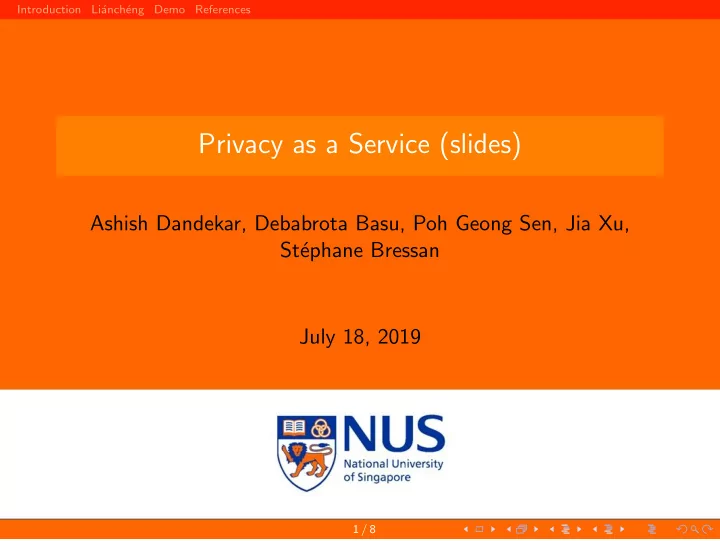

Introduction Li´ anch´ eng Demo References Privacy as a Service (slides) Ashish Dandekar, Debabrota Basu, Poh Geong Sen, Jia Xu, St´ ephane Bressan July 18, 2019 1 / 8
Introduction Li´ anch´ eng Demo References Motivation What are you doing to provide privacy-as-a-service (PaaS)? Because this is a service that consumers increasingly view less as a bonus and more as an absolute necessity. How are you preparing for the coming privacy revolt? (Wired, March 2015). 2 / 8
Introduction Li´ anch´ eng Demo References Overview of Li´ anch´ eng ◮ Workflow-as-a-Service. A data sharing cloud system that provides a graphical workflow language. ◮ Privacy-as-a-Service. A data sharing cloud system that provides operators to publish not only anonymised data but also models created by statistical machine learning with differential privacy guarantees. Li´ anch´ eng is deployed on a hardware infrastructure consisting of 128 commodity servers! 3 / 8
Introduction Li´ anch´ eng Demo References Li´ anch´ eng: A data sharing platform ◮ Li´ anch´ eng provides every user a private account that she uses to upload, download, organise and manage her data in the cloud. The internal sharing mechanism (user-to-user) relies on access control lists on directories. ◮ Li´ anch´ eng provides additional publishing mechanisms, such as public access through URLs, for files. ◮ Li´ anch´ eng provides both a web interface and a desktop computer synchronisation agent. 4 / 8
Introduction Li´ anch´ eng Demo References Li´ anch´ eng: Workflow-as-a-Service ◮ Li´ anch´ eng offers an interactive GUI-based workflow language and with domain specific operators that work on the data in the cloud. ◮ Li´ anch´ eng workflow is a directed acyclic graph whose vertices represent operators and whose edges represent data flow. An operator can have an arbitrary number of parameters and has at least one input or output interface. 5 / 8
Introduction Li´ anch´ eng Demo References Li´ anch´ eng: Privacy-as-a-Service ◮ Publishing data. Li´ anch´ eng provides traditional anonymisation operators such as k-anonymity [Sweeney, 2002], l-diversity [Machanavajjhala et al., 2006] and t-closeness [Li et al., 2007] . Alternatively, it also provides operators to synthetically generate datasets using differentially private machine learning model trained on private datasets. ◮ Publishing models. Li´ anch´ eng provides operators to publish parameters of parametric models using Functional mechanism [Zhang et al., 2012] and publishing non-parametric models using functional perturbation [Hall et al., 2012]. 6 / 8
Introduction Li´ anch´ eng Demo References Li´ anch´ eng: Screenshot 7 / 8
Introduction Li´ anch´ eng Demo References Demo 8 / 8
Introduction Li´ anch´ eng Demo References References I Hall, R., Rinaldo, A., and Wasserman, L. (2012). Random differential privacy. Journal of Privacy and Confidentiality , 4(2):43–59. Li, N., Li, T., and Venkatasubramanian, S. (2007). t-closeness: Privacy beyond k-anonymity and l-diversity. In Data Engineering, 2007. ICDE 2007. IEEE 23rd International Conference on , pages 106–115. IEEE. Machanavajjhala, A., Gehrke, J., Kifer, D., and Venkitasubramaniam, M. (2006). \ ell-diversity: Privacy beyond \ kappa-anonymity. In null , page 24. IEEE. Sweeney, L. (2002). k-anonymity: A model for protecting privacy. International Journal of Uncertainty, Fuzziness and Knowledge-Based Systems , 10(05):557–570. Zhang, J., Zhang, Z., Xiao, X., Yang, Y., and Winslett, M. (2012). Functional mechanism: regression analysis under differential privacy. Proceedings of the VLDB Endowment , 5(11):1364–1375. 8 / 8
Recommend
More recommend